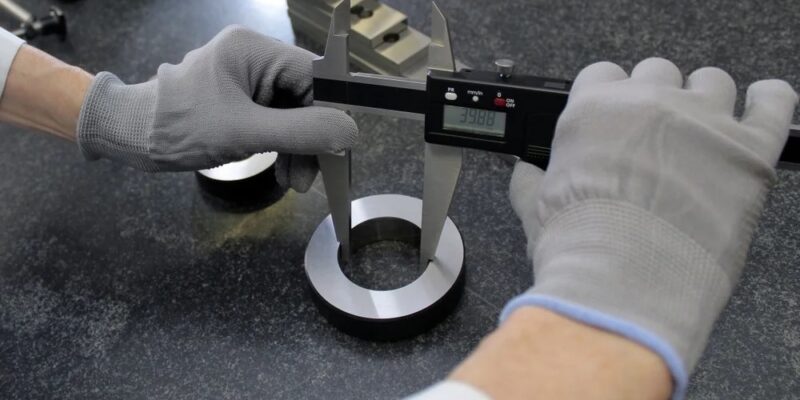
Introduction to Metrology in Aerospace Industry
Metrology plays a crucial role in ensuring the accuracy and efficiency of manufacturing processes in the aerospace industry. It involves the science of measurement and is essential for achieving precision in the production of aircraft components. The aerospace industry requires extremely high standards of quality and reliability, and metrology for aerospace provides the tools and techniques to meet these requirements.
What is Metrology and Why is it Important in Aerospace?
Metrology is the science of measurement, including all theoretical and practical aspects that ensure accuracy and precision. In the aerospace industry, metrology is crucial because even the smallest deviation from the desired specifications can have significant consequences. The measurement of aircraft components must be accurate to micrometer or even nanometer levels.
Accuracy in aerospace manufacturing is vital for several reasons. First, it ensures the safety of passengers and crew. Any errors or defects in critical components can lead to catastrophic failures. Second, accuracy contributes to the overall performance and efficiency of aircraft. Precisely manufactured parts reduce drag, improve fuel efficiency, and enhance overall aerodynamics. Lastly, accurate measurements are necessary for maintaining compliance with industry standards and regulations.
Evolution of Metrology in the Aerospace Industry
Metrology has evolved significantly over the years to keep pace with the advancements in aerospace technology. In the early days, manual measurement techniques were prevalent, which were time-consuming and prone to human errors. However, with the introduction of advanced technology, metrology has become more efficient and accurate.
Traditional measurement tools, such as calipers and micrometers, have been replaced by more sophisticated instruments. Coordinate measuring machines (CMMs) are now used to capture data points and generate precise 3D models of components. Optical measurement systems, including laser scanners and structured light scanners, offer high-speed and high-accuracy measurements.
The Role of Metrology in Ensuring Accuracy and Efficiency
Metrology plays a critical role in ensuring accuracy and efficiency in the aerospace industry. It enables manufacturers to measure and analyze complex geometries, ensuring that components meet the required tolerances. By verifying the dimensional accuracy of parts, metrology helps identify and mitigate any errors or deviations.
Moreover, metrology aids in the optimization of manufacturing processes. By providing accurate measurements, it helps identify areas for improvement, enabling manufacturers to refine their processes and reduce waste. This leads to increased efficiency and cost savings in the production of aircraft components.
The Latest Technological Advancements in Metrology
Technological advancements have revolutionized metrology in the aerospace industry, allowing for more precise and efficient measurements. These innovations have significantly improved the overall quality and safety of aerospace manufacturing processes.
3D Scanning: Revolutionizing the Measurement Process
One of the most remarkable advancements in metrology is the introduction of 3D scanning technology. 3D scanners can capture millions of data points on the surface of an object, creating a detailed digital representation of its geometry. This technology is particularly useful for measuring complex and irregular-shaped components.
With 3D scanning, aerospace manufacturers can quickly and accurately measure components without the need for physical contact. This eliminates the risk of damaging sensitive parts and allows for efficient measurement of intricate structures. The data captured by the 3D scanner can be used for analysis, quality control, and reverse engineering processes.
Laser Trackers: Increasing Precision in Aerospace Manufacturing
Laser trackers are another significant advancement in metrology that has greatly improved accuracy in aerospace manufacturing. These devices use laser beams to track the position and orientation of a target, allowing for precise measurements in three-dimensional space.
In the aerospace industry, laser trackers are used for various applications, including alignment, inspection, and assembly. They can ensure that aircraft components are correctly positioned and aligned during the manufacturing process. Laser trackers provide real-time feedback, minimizing errors and reducing the need for rework or adjustments.
Robotic Inspection Systems: Automating Quality Control
Robotic inspection systems have transformed the quality control process in aerospace manufacturing. These systems combine robotics with advanced metrology technologies, such as 3D scanners and laser trackers, to automate the inspection of aircraft components.
Robotic inspection systems offer numerous benefits, including increased speed and accuracy, reduced human error, and improved repeatability. These systems can perform complex inspections in a fraction of the time compared to manual methods. They can also operate in hazardous environments, ensuring the safety of human operators.
Challenges and Solutions in Metrology for Aerospace
Despite the advancements in metrology, the aerospace industry still faces several challenges in ensuring accurate and efficient measurements. These challenges arise from the complex nature of aerospace components and the industry’s stringent requirements.
Complex Geometric Measurements and Analysis
Aerospace components often have complex geometries, making their measurement and analysis challenging. Traditional measurement tools may not be suitable for capturing intricate features accurately. An example of such complexity is turbine blades, which have intricate aerodynamic designs.
To overcome this challenge, advanced metrology technologies like 3D scanning and optical measurement systems come into play. These technologies can capture and analyze complex geometries with high precision, ensuring that every intricate detail is measured accurately.
Environmental Conditions and Their Impact on Measurement Accuracy
The aerospace industry operates in a variety of environmental conditions, including extreme temperatures, humidity, and vibrations. These conditions can affect the accuracy of measurements and introduce errors in the metrology process.
To mitigate the impact of environmental conditions, specialized measurement systems are designed to operate under these challenging circumstances. For example, temperature-compensated measurement systems can maintain accuracy even in extreme temperature variations. Such systems ensure reliable measurement results, regardless of the environmental conditions.
Ensuring Traceability and Calibration in a Highly Regulated Industry
The aerospace industry is highly regulated, and traceability and calibration are crucial for compliance with industry standards. Every measurement should be traceable to national or international standards and must undergo regular calibration to ensure accuracy.
Metrology laboratories and calibration centers play a vital role in maintaining traceability and calibration in the aerospace industry. These facilities provide certified calibration services and ensure that the measurement equipment used in aerospace manufacturing meets the required accuracy standards. Regular calibration and traceability certification give manufacturers confidence in the accuracy of their metrology equipment.
Benefits of Adopting Advanced Metrology Solutions
Adopting advanced metrology solutions offers numerous benefits for the aerospace industry. These solutions enhance the overall performance, safety, and efficiency of aircraft manufacturing processes.
Improved Aircraft Performance and Safety
Accurate and precise measurements contribute to improved aircraft performance and safety. Well-measured components minimize drag, optimize fuel efficiency, and ensure proper functioning of critical systems. This, in turn, enhances the overall performance and reliability of the aircraft, reducing the risk of accidents and malfunctions.
Reduced Manufacturing Costs and Time Efficiencies
Advanced metrology solutions help identify and eliminate errors early in the manufacturing process, reducing the need for rework or scrap. This eliminates unnecessary costs and saves time, leading to significant cost efficiencies in aerospace manufacturing.
Furthermore, automation and robotics in metrology streamline the inspection process and reduce inspection time. Robotic inspection systems can perform inspections faster than manual methods, allowing for increased productivity and reduced time-to-market for aircraft components.
Enhanced Quality Control and Compliance with Industry Standards
Metrology plays a crucial role in maintaining and ensuring quality control in aerospace manufacturing. By accurately measuring and analyzing components, manufacturers can identify and resolve any defects or deviations from industry standards.
Advanced metrology solutions, such as 3D scanners and laser trackers, provide detailed information about the quality of components, enabling manufacturers to make informed decisions. This ensures that all aerospace components meet the required specifications and comply with industry standards and regulations.
In conclusion, metrology plays a vital role in enhancing accuracy and efficiency in the aerospace industry. Technological advancements have revolutionized metrology, enabling precise measurement and analysis of complex aerospace components. Despite the challenges posed by complex geometries and environmental conditions, advanced metrology solutions provide reliable measurements and ensure compliance with industry standards. The adoption of these solutions offers numerous benefits, including improved aircraft performance, cost efficiencies, and enhanced quality control. By embracing advanced metrology technologies, the aerospace industry can continue to push the boundaries of precision and reliability in aircraft manufacturing.
FAQ
Question: What is metrology? – Metrology is the science of measurement, encompassing all theoretical and practical aspects that ensure accuracy and precision.
Question: Why is metrology important in the aerospace industry? – Metrology is crucial in the aerospace industry because even the smallest deviation from desired specifications can have significant consequences. Accurate measurements are essential for safety, performance, and compliance with industry standards.
Question: How has metrology evolved in the aerospace industry? – Metrology has evolved from manual measurement techniques to advanced instruments such as Coordinate Measuring Machines (CMMs) and optical measurement systems like laser scanners and structured light scanners.
Question: What is the role of metrology in ensuring accuracy and efficiency? – Metrology plays a critical role in ensuring accuracy and efficiency by helping manufacturers measure and analyze complex geometries, identify errors, and optimize manufacturing processes.
Question: What are some technological advancements in metrology? – Technological advancements in metrology include 3D scanning, laser trackers, and robotic inspection systems. These innovations have significantly improved the quality and safety of aerospace manufacturing.
Question: What are the challenges in metrology for the aerospace industry? – Challenges in metrology for aerospace include measuring complex geometries and mitigating the impact of environmental conditions. Advanced metrology technologies and specialized measurement systems address these challenges.
Question: Why is traceability and calibration important in the aerospace industry? – In the highly regulated aerospace industry, traceability and calibration ensure compliance with industry standards. Metrology laboratories and calibration centers provide certified calibration services, maintaining accuracy and confidence in the metrology equipment used in aerospace manufacturing.
Question: What are the benefits of adopting advanced metrology solutions? – Adopting advanced metrology solutions in the aerospace industry offers benefits such as improved aircraft performance and safety, reduced manufacturing costs and time efficiencies, and enhanced quality control and compliance with industry standards.
Useful Resources:
- National Institute of Standards and Technology (NIST)
- ASM International
- American Society of Mechanical Engineers (ASME)
- International Organization for Standardization (ISO)
- National Physical Laboratory (NPL)
- Society of Manufacturing Engineers (SME)
- Aerospace Industries Association (AIA)
- American Institute of Aeronautics and Astronautics (AIAA)









